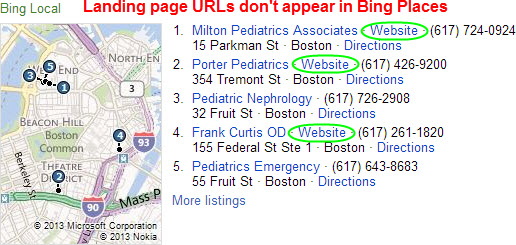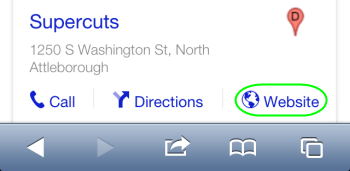
Some business owners think the best way to rank in many cities in the local search is to have many websites. That’s a losing strategy.
They build microsites – by which I mean a bunch of small, usually almost identical sites with names like:
PlumbingCompanyCambridge.com
PlumbingCompanySomerville.com
PlumbingCompanyWatertown.com
PlumbingCompanyMalden.com
PlumbingCompanyCharlestown.com
PlumbingCompanyWinthrop.com
PlumbingCompanyLynn.com
PlumbingCompanyChelsea.com
PlumbingCompanyRevere.com
There are two main scenarios where business owners feel tempted to use microsites:
Scenario 1. They’ve got a single-location business that serves customers in a wide area – like within a 50-mile radius. They know they probably can’t get visible in Google Places across that much terrain, so they want to pick up organic rankings in all those neighboring towns.
Scenario 2. They’ve got several locations – using addresses that Google considers legitimate – and want each Google Places page to lead to a website that has the city in the domain name.
Microsites are a bad wager in both situations. (They’re even a dumb move for ecommerce.)
That’s not to say some businesses don’t grab some OK local visibility with them – and maybe even some customers. But it’s relative: I can’t think of a situation when those businesses wouldn’t be better off using fewer sites.
Here’s my assessment of using microsites for local SEO:
Pros
- You can stuff the same city name into every greasy little crevice of the site, including the domain name.
Cons
- You’re spreading your content thin. Let’s say you have 8 sites and you bust your hump to create great info. Either you kinda-sorta help 8 sites, or you give them all boilerplate content, or one site gets all the benefit. Your desire to build good sites is caught between Scylla and Charybdis.
- It’s a similar challenge with any links you earn. (Not that you can create a bunch of sites with identical link profiles, unless they’re garbage links.) You’ll have multiple sites with mediocre link profiles, rather than one strong lineup.
- Even if all your sites saw an equally good boost from the content and links, you can’t help but imagine how much one site (or even a couple) would have benefited.
- If you only have one location it’s hard to figure out which site – if any – should get a crack at Google Places. Let’s say you’ve got 10 microsites. That probably doesn’t correspond to 10 physical locations or separately registered businesses. It’s more likely you’ve got just one location, in which case Google insists you can only have one Google listing. (Although there are a few exceptions).
- If you only have one location, you’ll be able to put your address info – an important ranking factor – on only one of the sites.
- If you do have multiple locations, there is no good reason you can’t just have location-specific landing pages.
- It’s easy to overdo the interlinking between your sites. You’ll always be tempted to add one more keyword-rich link from one keyword-rich URL to another. That’s a bad idea because…wait, quiet…I think I can hear Penguins waddling over to you.
- Higher costs: More domain names, hosting, and development expenses. That also makes you more likely to skimp on important investments – like help with local SEO, which you may need bad.
- It’s harder to manage all the sites. If you make a mistake, chances are you’ll end up needing to fix it 8 or 9 or 10 times. Sometimes pain has a purpose. Then there are those times you step on a Lego.
- You’re probably creating a bad user-experience. Your content likely will be thin. Or you’ve “geotargeted” your content with cutting-edge techniques like repeating 15 times on the page that your company is the leading “plumbers Dallas TX.” Would-be customers will know you’re just paying their city or town lip-service.
- It’s harder to tell people you talk with offline which website to check out.
- Are you really going to have 7 Facebook pages, 7 Twitter handles, 7 Google+ pages, etc. – that you don’t simply build, but also develop?
- What if you already have one “main” site that all your customers are used to going to?
- With nothing to differentiate your site other than a possible small advantage in the name, you’re one Google algorithm update away from the fiery pits of page 37.
My rule is simple: Have as few sites as possible.
Even if you think that number will end up being more than a handful of sites, figure out your exact reasons for having that many sites. If your reasons begin with “Because Google…” then you’re probably headed for trouble sooner or later.
Ideally you have one site that you grow into a beast, through focus and sustained effort.
But however many sites you have, you’ll get out of them exactly what you put into them.
—
What’s been your experience with microsites? Anything you want to say in favor of them? Leave a comment!









